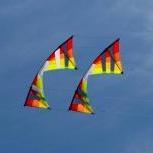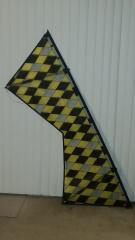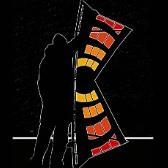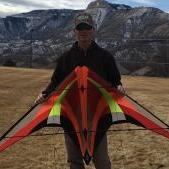Leaderboard
Popular Content
Showing content with the highest reputation on 10/25/2019 in all areas
-
Full vent -- sure, no problem. Midvent would work too. How steady the wind is would the deciding factor. You fly the lower of the shifts. Fifteen would be uncomfortable with a standard sail. I would definitely want vented. Safe would be what you make it. Safe for the kite, and safe for the people near it are both important. The kite can be repaired easily and at lower cost.2 points
-
The newer models, like the Djinn, have improvements to the panel design, bridle and other features than have over time been shown to improve performance, as well as improvements/reinforecements that have been shown to reduce wear. Many of the original and older designs have not yet begun to put these improvements into their kites. The less expensive kites are known to have panels designed to look good instead of performing well, lower grade materials, inconsistent sewing and poor quality construction overall. Ask Edmond about the first quad kite he ever owned. He got a really good price, but not much else. The less expensive kites may also have lower weave density lines which will bind more quickly in less spins. You get what you pay for. Your VW Beetle will not perform like a Mustang, and the Mustang will not perform like a Ferrari. The problem is when you pay for less than a Mustang and get much less than a Beetle.2 points
-
From the album: Riffclown's Homemades
72" LE, Balanced Venting and ready to fly. Recommended Wind Range 15 - 30 MPH1 point -
thanks John and hello everyone. i'm a kite addict i was loaned a skydog little wing last may, kinda learned to fly it and the rest is history as you all know. since then i bought a few prism kites...nexus,quantum,zephyr,jazz,hypnotist,e3. after awhile i outgrew the quantum and gave it to my youngest son who was trying to wreck it anyway, gave the jazz to my wife, and gave my next older son the hypnotist to repay him for the loan of his little wing. well that put a dent in my quiver...so i got a hydra and liked it so much i got another (for the wife)...and so it goes... we live along the columbia river about 50 miles downstream from portland, oregon so i hope to get with local flyers and mix it up. i fly at kalama on a spit of sand about 200yds by 400 yds on the river-nice wind. i also fly at willow grove park, also on the river west of longview. i invite any and all to come check it out. thats it for now, thanks again for the welcome. BobL1 point
-
Yeah, ground flying is tough on kites and rips them to shreds. Sliding along the ground quickly eats through anything from Kevlar to Icarex. Even the Djinn with aluminum tips get chewed up a bit sliding on the ground or landing on pavement. Avoid ground flying at any temperature. 😉 Fly, use it, enjoy it. Parts will eventually break, it is part of the sport. You generally don't see soccer players worrying about mud and gravel that shreds the $15 ball, or tennis players that must replace balls every few weeks as they lose pressure. Sometimes you need to order additional spars, they break and it is normal. Crash less and they break less often, but they still break.1 point
-
Agreed about wanting at least a mid vent. If the weather station said fifteen but the actual flying field was in a bowl surrounded by trees, go for it. That local wind is lighter than the prevailing conditions. If it was light but gusty, say 5G15, sure the standard sail would work but you must be ready to dart outside the wind window at strong winds, then right back as it powers down. If it was a steady 15 off the ocean I would strongly recommend a full vent, even consider a loan to a stranger rather than watching them stretch and harm their standard sail.1 point
-
I can imagine hundreds of twists shrinking perhaps an inch, probably less. I'm also old enough to have learned on twisted rather than braided line, twists don't bother me at all. But really you should equalize often, if you fly aggressively do it before every flight. There are grips by prism and others with leader lines. Making your own is not difficult. You can add knots at short intervals or just tie one leader a little shorter, either way it is a quick and tiny adjustment.1 point
-
IMO before to buy a XX or RX ore any other reflex technologies try to fly one. is very possible to do not be at your expectations from millions reasons. if you like old stile Revolutions try Djinn or Phoenix1 point
-
They do, but not enough to worry about. It's the frames that suffer more from being "frozen". Letting a wet sail freeze is not as bad as it sounds. I've done it without dire consequences, but it can damage the sail material if the circumstances are "perfect". Usually if you don't make hard contact with the ground or other things in cold weather, you'll be fine. A little caution goes a long way.1 point
-
It's possible that someone NEW at Premier Kites unwound line by rolling it off the spool and for some reason did not need the line unwound so wound the line back onto the spool with the winding "crank" motion which puts a half-twist in the line with each wind. The rest you can figure out. Came back from lunch or the next day and unwound it by rolling it to make a line and no one noticed. Untwist and equalize and you'll be fine. The line was probably half of a foot longer which made the kite fly wonky, and a full foot after you unwound it -- even wonkier. Putting 30 or 40 twists in a line can shorten it by a foot, or close to it, assuming you exaggerated just a "touch". Spectra line is braided so strands cross in opposite directions. You can get all the twists out by staking down the lines at one end with nothing attached at the other end, and walking them down to the loose end from the stake between your fingers with a bit of pressure one at a time, doing each two or maybe three times. And yes, you can see the twists by sighting down the line. A couple or six is nothing to worry about. More than that may affect flight. This is exactly the kind of question that should be asked on this forum. This is how the knowledge base expands. Any question you have, one or more of us has asked when we were just starting, so fire away.1 point
-
1 point
-
more then enough if you have a minimum experience. on that wind any mistake will lead you to a crash and for sure to a broken spare. IMO in days with more than 7 mph winds i will recommend you at least 65' to have enough time to recover1 point
-
That's the standard. As with the WidowMaker, I don't see the use of having an UL. Both fly down to about 3mph while still being able to trick. Sorry to hear about your UL, is it totaled ?1 point
-
opps! you're missing one of the true master class quad-lined builders from your list, Eliot (the Shook Mesh) ~ Flying Smiles Kites, he's made like about 300 of 'em for at least 500 USD ea and they are worth every penny, ask any owner!1 point
-
You've brought up a very good point in this comment. Icarex and RipStop Nylon (RSN) are two similar yet very different materials. The key difference for this conversation being water absorbency. Icarex is by design pretty resilient and it absorbs very little moisture. RSN however varies widely due to age, coatings etc. Depending on those factors to a degree, RSN WILL absorb water and get heavy quickly.. Knowing that RSN will get soaked, I can think of one scenario that if you carry a water drenched Nylon kite out in sub freezing temps, let it freeze and fly it frozen, the frozen water crystals in the fabric would be sharp and could cause accelerated wear/failure. This is a very specific set of circumstances that most people would avoid anyway out of common sense but it does highlight the specific differences in the fabric itself. If you are flying in 40 below, Have fun and good luck. (Fun Fact, 40 Below is the one temp the Celsius = Fahrenheit. ( -40C = -40F ))1 point
-
You might be crazy. Lol. If one line has severely been twisted it would shorten the overall length of the line. I haven’t seen this with kite lines before but in theory it could happen. Almost every kite I’ve bought that came with lines they were not equal. I’ve seen on multiple occasions the lines being 6 inches or more off. I make my own lines now from 900 to 1000 foot spools of line. I recommend staking the lines and getting the twists out of them. Then equalize them by untying the knots and moving the sleeving down on the longer one until they are equal. Good luck.1 point
.thumb.jpg.53aabc63a639af8d375b2c92cf2e13f8.jpg)





